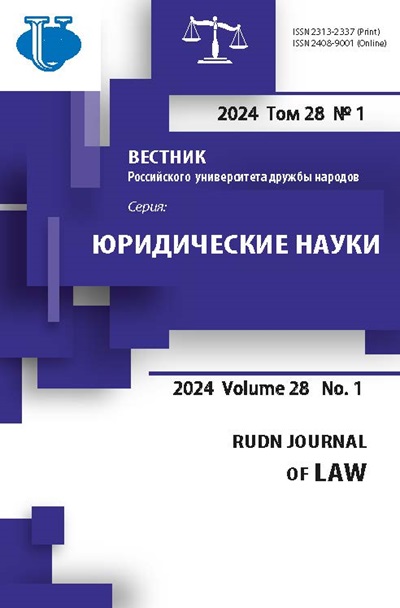Information technologies in judicial process: opportunities of artificial intelligence in evidence system
- Authors: Sherstoboev O.N.1, Mikheeva I.V.2
-
Affiliations:
- Novosibirsk State University of Economics and Management
- HSE University
- Issue: Vol 28, No 1 (2024)
- Pages: 178-195
- Section: LAW AND DIGITAL TECHNOLOGIES
- URL: https://journals.rudn.ru/law/article/view/38386
- DOI: https://doi.org/10.22363/2313-2337-2024-28-1-178-195
- EDN: https://elibrary.ru/QVAPEZ
- ID: 38386
Cite item
Abstract
The study is devoted to ambiguous issues of using artificial intelligence (AI) in judicial process. The purpose of the study is to present foreign experience of using information technologies in court proceedings based on the example of the most controversial and debated ideas concerning resources of artificial intelligence in the system of evidence. Special attention is paid to successful mechanisms of using AI in foreign judicial practice at the stage of evidence assessment. The study presents several decisions of foreign courts, formed with the help of AI. The findings allow to express opinion about admissibility of evidence evaluated by AI. The study employs methods of general scientific cognition and special methods including comparative legal. The dialectical method allows to investigate genesis and progressive development of judicial process technologization. The methods of analysis and synthesis, induction and deduction contribute to highlighting disadvantages of predictive coding at the proving stage and advantages of electronic research of evidence, options for simultaneous disclosure of evidence using different methods on the example of specific court decisions. The comparative legal method helps to identify best practices of using artificial intelligence in the system of evidence in foreign countries. The study not only describes the tools of predicting justice in European judicial practice, but also examines the problems of Chinese "instrumental justice" that can arise in any country. Conclusion justifies predictive coding as a tool of predictive justice, provided that general rules for information disclosure are developed and specifics of machine learning for a particular case are considered. It is noted that artificial intelligence has not yet become the predominant method in any types of legal proceedings. This may be explained by insufficient confidence in it across legal communities and time needed to form a successful history of its use for solving legally significant tasks in various spheres of human life.
About the authors
Oleg N. Sherstoboev
Novosibirsk State University of Economics and Management
Email: sherson@yandex.ru
ORCID iD: 0000-0001-6972-8241
Candidate of Legal Sciences, Associate Professor, Dean of Law Faculty
56 Kamenskaya str., Novosibirsk, 630099, Russian FederationIrina V. Mikheeva
HSE University
Author for correspondence.
Email: imikheeva@hse.ru
ORCID iD: 0000-0001-9323-6511
SPIN-code: 3237-4119
Doctor of Legal Sciences, Head of the Constitutional and Administrative Law Department
25/12 Bolshaya Pecherskaya str., Nizhny Novgorod, 603000, Russian FederationReferences
- Aletras, N., Tsarapatsanis, D., Preoţiuc-Pietro, D. & Lampos, V. (2016) Predicting Judicial Decisions of the European Court of Human Rights: a Natural Language Processing Perspective. PeerJ Computer Science. 2:e93. https://doi.org/10.7717/peerj-cs.93
- Alison (Lu) Xu (2017) Chinese judicial justice on the cloud: a future call or a Pandora’s box? An analysis of the ‘intelligent court system’ of China. Information & Communications Technology Law. 26(1), 59-71. http://dx.doi.org/10.1080/13600834.2017.1269873
- Asimov, I. (1991) I Robot. New York, Bantam Books.
- Barak, A., (1999) Judicial Discretion. Moscow, Norma Publ. (in Russian).
- Biryukov, P.N. (2019) Artificial Intelligence and “Predicted Justice”: Foreign Experience. Lex Russica. 11(156), 79-87. https://doi.org/10.17803/1729-5920.2019.156.11.079-087 (in Russian).
- Bonner, A.T. (2017), Selected Works: in 7 vols. V. Problems of the Theory of Judicial Evidence. Moscow, Prospect Publ. (in Russian)
- Byram, E. (2013) The Collision of the Court and Predictive Coding: Defining Best Practices and Guidelines in Predictive Coding for Electronic Discovery. Santa Clara High Technology Law Journal. 29(4), 675-701.
- Dvorkin, R. (2004) Taking Rights Seriously. Moscow, ROSSPEN Publ. (in Russian).
- Fokina, M.A. (2019) Law of Evidence in the Civil Procedure: Unrealized opportunities. Herald of Civil Procedure. (1), 29-46. (in Russian).
- Hart, H.L.A. (2013) Discretion. Harvard Law Review. 127(2), 652-665.
- Kudryavtseva, E.V. & Smolnikov, D.I. (2019) The court’s role in the proof of facts in the light of civil justice reform. Zakon. (4), 104-113. (in Russian).
- Locke, J. (2009) Two Treatises on Governance. Moscow, “Canon +” ROOI “Rehabilitation” Publ. (in Russian).
- Montesquieu, S.-L. (1900) The Spirit of Laws or on the Relations in which Laws should be to the Government, Morals, Climate, Religion, Trade, etc. Saint Petersburg, From L.F. Panteleev. (in Russian).
- Murphy, Tonia Hap (2013) Mandating Use of Predictive Coding in Electronic Discovery: An Ill-Advised Judicial Intrusion. American Business Law Journal. 50(3), 609-657.
- Sheremetyeva, N.V., Baturo, I.V. & Y SH (2020) Features of Electronic Justice in China. Law and practice. (2), 159-163. (in Russian).
- Shu Shang C. & Guo, W. (2020) The Rise of Online Dispute Resolution-Led Justice in China: an Initial Look. Australian National University Journal of Law and Technology. 1(2), 35-41.
- Smagina, E.S. (2019) Is the Procedural Revolution Completed? Bulletin of Civil Procedure. (4), 119-123. (in Russian).
- Stepanov, O.A., Pechegin, D.A. & Dyakonova, M.O. (2021) Towards the Issue of Digitalization of Judicial Activities. Law. Right. Journal of the Higher School of Economics. (5), 4-23. https://doi.org/10.17323/2072-8166 .2021.5.4.23 (in Russian).
- Treushnikov, M.K. (2016) Judicial Evidence. Moscow, Gorodets, Publ. (in Russian).
- Wang, Zh. (2021) The Supreme People’s Court of China has Embraced Blockchain, Built online Courthouses, and Moved to Digitalize Court Systems in a Bold Embrace of Technology. Here’s How it’s Going. Judicature. 105(1), 38-40.
Supplementary files















